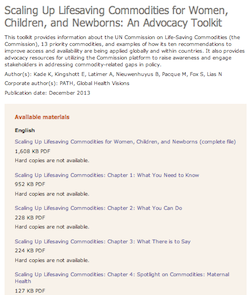Scaling Up Lifesaving Commodities for Women, Children, and Newborns: An Advocacy Toolkit
This toolkit provides information about the UN Commission on Life-Saving Commodities (the Commission), 13 priority commodities, and examples of how its ten recommendations to improve access and availability are being applied globally and within countries. It also provides advocacy resources for utilizing the Commission platform to raise awareness and engage stakeholders in addressing commodity-related gaps in policy. Scaling Up Lifesaving Commodities for Women, Children, and Newborns: An Advocacy Toolkit Year of Publication: 2013 Organization: PATH, Global Health Visions Author(s): Kade K, Kingshott E, Latimer A, Nieuwenhuyus B, Pacque M, Fox S, Lias N

